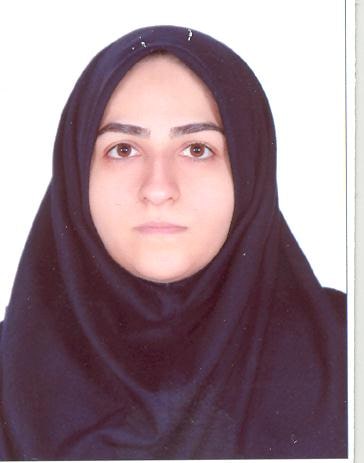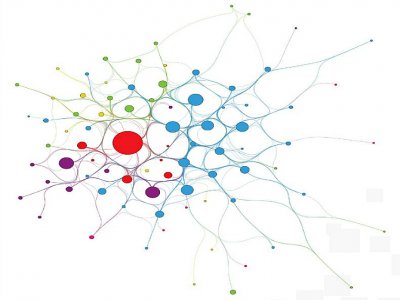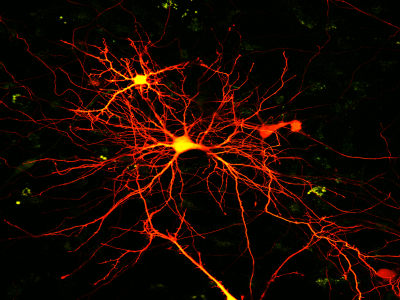Achievements and Future works
Previous work of the lab focused on the interaction between three parameters: (1) sensory representation in the primary sensory cortex (Barrel cortex neuronal activity), (ii) neuromodulation (Locus Coeruleus neuronal activity as a main source of norepinephrine) and (iii) cortical state (identified by EEG). Our findings support the involvement of the LC neuromodulatory system in the desynchronization of cortical state and a consequent enhancement of sensory coding efficiency.
Our current work is mainly focused on the effect of dopamine on cortical and subcortical activity including pairwise correlation between neurons in cortico-basal-thalamo-cortical loops especially in the context of PD. We hope that the combined results from our work lead to better models for the role of these two key neuromodulators in modifying the state space of cortical and subcortical activity and their functional connectivity.
Goals
Parkinson's disease is accompanied by excessive beta oscillations and bursting activity in the basal ganglia due to loss of dopamine. These oscillations result in perturbations of motor command causing movement disorders which are the hallmarks of PD. The mechanism of the generation of these oscillations is poorly understood. One hypothesis points to the role of rebound burst activity of the basal ganglia neurons which is thought to be caused by low threshold calcium channels (T-type calcium). Based on this hypothesis, a simple prediction is that aberrant beta oscillations and disturbances in transmission of motor commands via cortico-basal-thalamo-cortical loops should improve with blocking of the T-type calcium channels in the neurons.
We create a rodent model of PD with injection of 6-hydroxydopamine (6-OHDA), a selective dopaminergic neurotoxin to the substantia nigra pars reticulata in the basal ganglia. During anaesthetized recording sessions, the neural activity and local field potentials in Substantia Nigra reticulata (SNr) - the basal ganglia output, VA/VL nuclei of thalamus which are the target of SNr and the motor cortex are recorded. In some sessions pairs of functionally connected neurons between SNr and thalamus and between motor cortex and thalamus will be isolated to analyze the degree of firing rate and LFP correlation including beta oscillations in PD as well as in healthy animals. The orthodromic effect of SNr on thalamus and from thalamus to motor cortex will also be contrasted in PD and healthy models with and without T-type calcium blockers. The data obtained will be used to fine tune computational models of cortico-basal-thalamo-cortical loops in health and disease.
About
Rodent electrophysiology lab works on the effects of neuromodulators such as dopamine and norepinephrine on spontaneous and evoked activity across basal ganglia, thalamus and cortex. To this end, this lab does invasive anesthetized neural recordings from the rodent brain and also constructs computational models for understanding the observed effects at the circuit level. Current focus of the lab is about understanding the role of L-type and T-type calcium channels in the etiology of Parkinson's disease (PD) using the rodent model of the disease.
Team
.

Ali Ghazizadeh, PhD
Principal Investigator
alighazizadeh [at] ipm [dot] ir

Mohammad Amin Al-e-Mohammad
Investigator
smaam1373 [at] gmail [dot] com

Milad Yekani
Investigator
yekanimilad2 [at] gmail [dot] com

Leila Abbasi
Investigator
Abbasil28758 [at] gmail [dot] com

Elham Alaee
Researcher
elham.22445 [at] gmail [dot] com

Shiva Hashemizadeh
Postdoc Researcher
shiva.hashemi.66 [at] gmail [dot] com

Elmira Ghasemi
PhD Student
elmiraghasemi68 [at] ipm [dot] ir
Adjunct Investigators
.

Zeinab Fazlali, PhD
Adjunct Investigator
zfazlali [at] ipm [dot] ir

Seyed Mojtaba Alavi
Adjunct Investigator
alavimojtabaseyed [at] gmail [dot]com
Goals
Parkinson's disease is accompanied by excessive beta oscillations and bursting activity in the basal ganglia due to loss of dopamine. These oscillations result in perturbations of motor command causing movement disorders which are the hallmarks of PD. The mechanism of the generation of these oscillations is poorly understood. One hypothesis points to the role of rebound burst activity of the basal ganglia neurons which is thought to be caused by low threshold calcium channels (T-type calcium). Based on this hypothesis, a simple prediction is that aberrant beta oscillations and disturbances in transmission of motor commands via cortico-basal-thalamo-cortical loops should improve with blocking of the T-type calcium channels in the neurons.
We create a rodent model of PD with injection of 6-hydroxydopamine (6-OHDA), a selective dopaminergic neurotoxin to the substantia nigra pars reticulata in the basal ganglia. During anaesthetized recording sessions, the neural activity and local field potentials in Substantia Nigra reticulata (SNr) - the basal ganglia output, VA/VL nuclei of thalamus which are the target of SNr and the motor cortex are recorded. In some sessions pairs of functionally connected neurons between SNr and thalamus and between motor cortex and thalamus will be isolated to analyze the degree of firing rate and LFP correlation including beta oscillations in PD as well as in healthy animals. The orthodromic effect of SNr on thalamus and from thalamus to motor cortex will also be contrasted in PD and healthy models with and without T-type calcium blockers. The data obtained will be used to fine tune computational models of cortico-basal-thalamo-cortical loops in health and disease.
About
Rodent electrophysiology lab works on the effects of neuromodulators such as dopamine and norepinephrine on spontaneous and evoked activity across basal ganglia, thalamus and cortex. To this end, this lab does invasive anesthetized neural recordings from the rodent brain and also constructs computational models for understanding the observed effects at the circuit level. Current focus of the lab is about understanding the role of L-type and T-type calcium channels in the etiology of Parkinson's disease (PD) using the rodent model of the disease.
Team
.

Ali Ghazizadeh, PhD
Principal Investigator
alighazizadeh [at] ipm [dot] ir

Mohammad Amin Al-e-Mohammad
Investigator
smaam1373 [at] gmail [dot] com

Milad Yekani
Investigator
yekanimilad2 [at] gmail [dot] com

Leila Abbasi
Investigator
Abbasil28758 [at] gmail [dot] com

Elham Alaee
Researcher
elham.22445 [at] gmail [dot] com

Shiva Hashemizadeh
Postdoc Researcher
shiva.hashemi.66 [at] gmail [dot] com

Elmira Ghasemi
PhD Student
elmiraghasemi68 [at] ipm [dot] ir
Adjunct Investigators
.

Zeinab Fazlali, PhD
Adjunct Investigator
zfazlali [at] ipm [dot] ir

Seyed Mojtaba Alavi
Adjunct Investigator
alavimojtabaseyed [at] gmail [dot]com
About
Rodent electrophysiology lab works on the effects of neuromodulators such as dopamine and norepinephrine on spontaneous and evoked activity across basal ganglia, thalamus and cortex. To this end, this lab does invasive anesthetized neural recordings from the rodent brain and also constructs computational models for understanding the observed effects at the circuit level. Current focus of the lab is about understanding the role of L-type and T-type calcium channels in the etiology of Parkinson's disease (PD) using the rodent model of the disease.
Team
.

Ali Ghazizadeh, PhD
Principal Investigator
alighazizadeh [at] ipm [dot] ir

Mohammad Amin Al-e-Mohammad
Investigator
smaam1373 [at] gmail [dot] com

Milad Yekani
Investigator
yekanimilad2 [at] gmail [dot] com

Leila Abbasi
Investigator
Abbasil28758 [at] gmail [dot] com

Elham Alaee
Researcher
elham.22445 [at] gmail [dot] com

Shiva Hashemizadeh
Postdoc Researcher
shiva.hashemi.66 [at] gmail [dot] com

Elmira Ghasemi
PhD Student
elmiraghasemi68 [at] ipm [dot] ir
Adjunct Investigators
.

Zeinab Fazlali, PhD
Adjunct Investigator
zfazlali [at] ipm [dot] ir

Seyed Mojtaba Alavi
Adjunct Investigator
alavimojtabaseyed [at] gmail [dot]com





